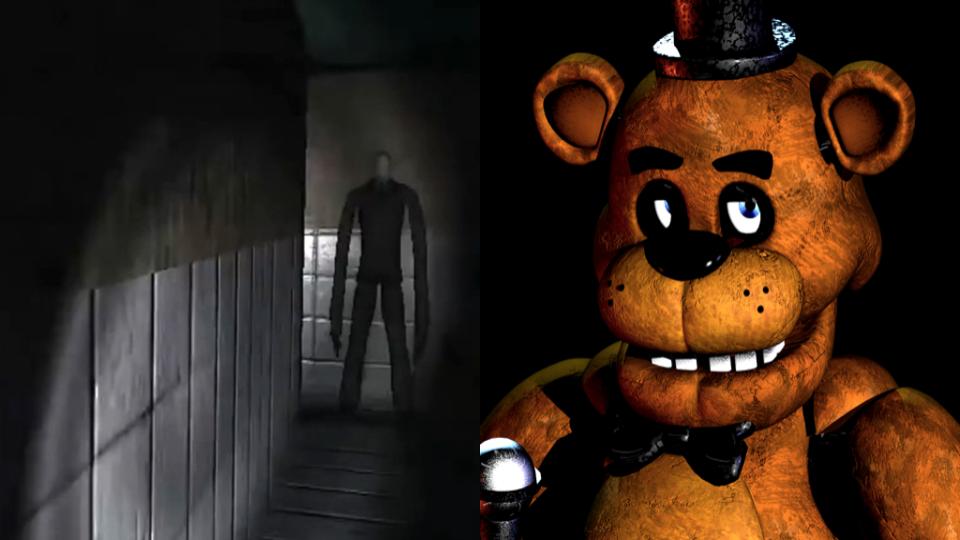This summer, I worked part-time at Big Lots. One day I had to mark down the prices of a shipment of calendars. To my surprise, the majority of the calendars were of Internet culture. Some of these were animals like Grumpy Cat and Doug the Pug, which seemed like a savvy business deal to me because pets are inherently good and deserve the world. But the other kinds of calendars were of the horror game Five Nights at Freddy’s. This game, in case you don’t know, is where you play as a security guard in their office at a spoof of Chuck E. Cheese’s. Your job is to check the security cameras, where the animatronics led by the eponymous Freddy Fazbear can be seen roaming the restaurant. The catch is that they want to kill you (they’ve killed someone before) and every time you protect yourself by checking the dark hallway by turning on the dim lights or shutting the doors to keep anything out, you use up battery that keeps you from being able to scan the security cameras to know where the animatronics are. If you run out of battery before the end of your shift, Freddy or one of his friends will get you and scare you by having their presence announced with musical box music or by jumping in your face and screaming if you’re caught when you’re checking the security camera. The game is super effective despite being simple, and for someone who doesn’t play video games that often I can tell you it took me time to win the game. Imagine my shock when a customer in her late 30s or early 40s came to buy a calendar of the game for what I assume was her small child. How could kids be such passionate fans of such horror?
I think part of it is that the characters of the game are easily marketable. They are distinctive anthropomorphic animals, which make up many popular characters used for mass production, and are based on a familiar cultural institution in America. I’ve heard of girls in middle school who would destroy their Barbie dolls in an effort to show how mature they had become by turning their backs on their childhood. I think it’s possible young fans of the game want to do the same thing by turning a place that brought them innocent fun with other children their age into a warped nightmare that makes them feel grown-up by withstanding the sinister story of Five Nights, proving they aren’t scared of the dark anymore and that they can handle taking away the sugar-coating of the robots their parents paid to entertain them. The fact that the game has turned into a series of five installments and has a film adaptation in the works produced by Blumhouse Productions is testament to how popular it is.
But where did these little kids hear about the game in the first place? I for one first heard about it from the many gamers on YouTube who posted videos playing the game upon its release in 2014. The journalist Shane Digman for the Canadian newspaper The Globe and Mail believes that the merchandise to the game from the popular collectibles company Funko Pop may actually be an effective kind of advertising to introduce the game to children. He raises the question of whether or not this can be done in good conscious, seeing as how children can have psychological repercussions from being exposed to horror that causes them fear. The thought that the child-friendly inspiration of Five Nights at Freddy’s could lead it to be misinterpreted as a game for children makes me sad, because not only could it put little kids through unnecessary stress if they play the game when they’re too young, but it also defines video games as a medium for children that cannot be taken seriously if it explores the dark nature of what is considered innocent.
One of the reasons presented in Digman’s article as to why young people playing horror games would be a bad idea is because their brains are still developing and can’t distinguish fact from fiction yet. That brings to mind the horrifying attempted murder of a 12 year-old Wisconsin girl by two mentally ill girls her age in 2014, where the perpetrators claimed they wanted to gain Slender Man’s approval and protect their families from him with a sacrifice. Slender Man is an urban legend created by Eric Knudsen in 2009, a cryptid who is tall without facial expressions that can teleport and stalks his prey (notably children) in forests. Thankfully the victim survived the attack, but it’s tragic that a character who is known to be fictional could inspire such a horrifying act. I, like most people I know, was introduced to Slender Man through the video game based on the urban legend called Slender: The Eight Pages. I find it interesting that the game found success like FNAF did through viral videos on YouTube of gamers playing the game, gaining many young fans as a result. There is something deeply fascinating about a modern day myth that can be put into many settings in our country. The scary nature of these two games, however, makes me wonder if there’s something beneath the surface of the current generation of youth that would make them feel validated somehow by such scary creatures that would threaten people like them in the real world.




